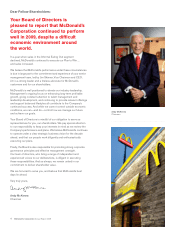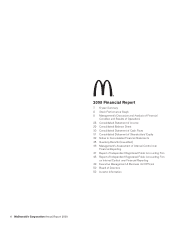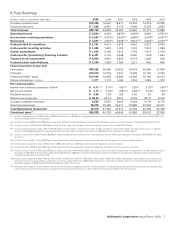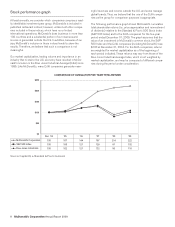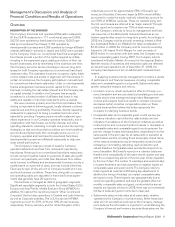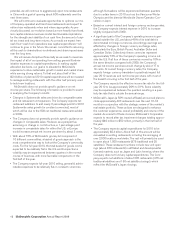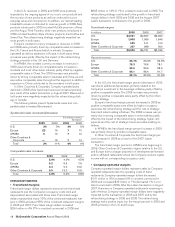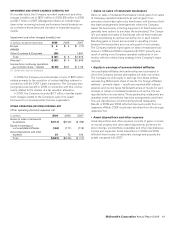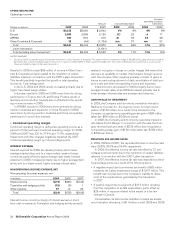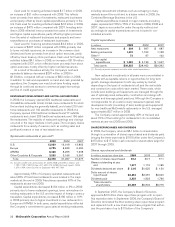McDonalds 2009 Annual Report Download - page 14
Download and view the complete annual report
Please find page 14 of the 2009 McDonalds annual report below. You can navigate through the pages in the report by either clicking on the pages listed below, or by using the keyword search tool below to find specific information within the annual report.potential, we will continue to aggressively open new restaurants
in China with a goal of opening about 600 restaurants over the
next three years.
We will continue to evaluate opportunities to optimize our mix
of Company-operated and franchised restaurants and expect to
refranchise restaurants when and where appropriate. As pre-
viously discussed, our evolution toward a more heavily franchised,
less capital-intensive business model has favorable implications
for the strength and stability of our cash flow, the amount of capi-
tal we invest and long-term returns. As a result, we expect free
cash flow—cash from operations less capital expenditures—will
continue to grow in the future. We remain committed to returning
all this cash to shareholders via dividends and share repurchases
over the long term.
We will remain disciplined financially as we seek to maximize
the impact of all of our spending from selling, general & admin-
istrative expenses to capital expenditures. In making capital
allocation decisions, our goal is to elevate the McDonald’s
experience to drive sustainable growth in sales and market share
while earning strong returns. To that end, about half of the
$2.4 billion of planned 2010 capital expenditures will be invested
to reimage existing restaurants with the other half primarily used
to build new locations.
McDonald’s does not provide specific guidance on net
income per share. The following information is provided to assist
in analyzing the Company’s results:
• Changes in Systemwide sales are driven by comparable sales
and net restaurant unit expansion. The Company expects net
restaurant additions to add nearly 2 percentage points to 2010
Systemwide sales growth (in constant currencies), most of
which will be due to the 609 net traditional restaurants added
in 2009.
• The Company does not generally provide specific guidance on
changes in comparable sales. However, as a perspective,
assuming no change in cost structure, a 1 percentage point
increase in comparable sales for either the U.S. or Europe
would increase annual net income per share by about 3 cents.
• With about 75% of McDonald’s grocery bill comprised of
10 different commodities, a basket of goods approach is the
most comprehensive way to look at the Company’s commodity
costs. For the full year 2010, the total basket of goods cost is
expected to be relatively flat in the U.S. and Europe. Some
volatility may be experienced between quarters in the normal
course of business, with more favorable comparisons in the
first half of the year.
• The Company expects full-year 2010 selling, general & admin-
istrative expenses to be relatively flat, in constant currencies,
although fluctuations will be experienced between quarters
due to certain items in 2010 such as the Vancouver Winter
Olympics and the biennial Worldwide Owner/Operator Con-
vention in April.
• Based on current interest and foreign currency exchange rates,
the Company expects interest expense in 2010 to increase
slightly compared with 2009.
• A significant part of the Company’s operating income is gen-
erated outside the U.S., and about 45% of its total debt is
denominated in foreign currencies. Accordingly, earnings are
affected by changes in foreign currency exchange rates,
particularly the Euro, British Pound, Australian Dollar and
Canadian Dollar. Collectively, these currencies represent
approximately 70% of the Company’s operating income out-
side the U.S. If all four of these currencies moved by 10% in
the same direction compared with 2009, the Company’s
annual net income per share would change by about 17 to
19 cents. At current foreign currency rates, the Company
expects foreign currency translation to positively impact full
year 2010 revenues and net income per share, with most of
the benefit occurring in the first half of the year.
• The Company expects the effective income tax rate for the full-
year 2010 to be approximately 29% to 31%. Some volatility
may be experienced between the quarters resulting in a quar-
terly tax rate that is outside the annual range.
• McDonald’s Japan (a 50%-owned affiliate) announced plans to
close approximately 430 restaurants over the next 12-18
months in conjunction with the strategic review of the market’s
real estate portfolio. These actions are designed to enhance
the customer experience, overall profitability and returns of the
market. As a result of these closures, McDonald’s Corporation
expects to record after tax impairment charges totaling approx-
imately $40 million to $50 million, primarily in the first half of
the year.
• The Company expects capital expenditures for 2010 to be
approximately $2.4 billion. About half of this amount will be
reinvested in existing restaurants, including the reimaging of
over 2,000 locations worldwide. The rest will primarily be used
to open about 1,000 restaurants (975 traditional and 25
satellites). These restaurant numbers include new unit open-
ings (about 350 restaurants) in affiliated and developmental
licensed markets, such as Japan and Latin America, where the
Company does not fund any capital expenditures. The Com-
pany expects net additions of about 325 restaurants (475 net
traditional additions and 150 net satellite closings), which
reflect the McDonald’s Japan closings.
12 McDonald’s Corporation Annual Report 2009




